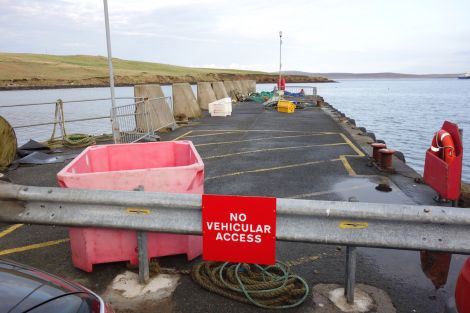News / Toft pier’s future in doubt
THE FUTURE of Shetland’s most dilapidated small pier has been thrown into doubt after councillors were told it would cost up to £2 million to replace.
Toft pier has fallen into such a state of disrepair that it has been closed to pedestrians and vehicles, with holes in the boardwalk and infill washing out of the steel pilings.
The pier was built in 1951 and refurbished in 1971 since when it has received little or no maintenance.
Ten years ago the Yell ferries stopped using it after a new terminal was built to accommodate larger vessels.
But there are still five scallop boats and a few salmon and mussel boats that regularly berth at the old facility, which also comes in handy when a fishing boat needs to come ashore in a hurry.
The council was considering demolishing the pier, which would cost at least £500,000.
However after an intervention from Shetland North councillor Alastair Cooper at last week’s harbour board, the council will now hold talks with the fishing industry about the pier’s future.
Shetland Fish Producers’ Organisation chief executive Brian Isbister said the industry had “a very strong desire” to keep the pier open.
“I am delighted the council now seems to be looking at other options than closure, which seemed to be on the agenda for this week’s meeting,” he said.
Isbister said piers were vital for the future of Shetland’s maritime industries, whether that be fish catching, aquaculture or marine renewables.
He added that with Collafirth and Sella Ness piers too busy to take more vessels, the nearest mainland pier to Toft was West Burrafirth on the other side of Shetland.
The council will have to prove a business case for replacing the pier, yet it has no clear idea of how to pay for it.
Become a member of Shetland News
Toft pier generates an annual income of just £2,300 in harbour dues, not enough to pay for even a fraction of the work required.
SIC infrastructure director Maggie Sandison said harbour dues would have to be increased to pay for the replacement.
The harbour account, which is separate from the council’s other finances, could borrow the money from the council to carry out the work and then it would be a matter of how long the payback period was.
“We have lots of assets we can’t afford to maintain into the future and we have to begin to prioritise, and the way to do this is to sit down with industry and discuss with them where the money should go,” Sandison said.
Become a member of Shetland News
Shetland News is asking its readers to consider paying for membership to get additional perks:
- Removal of third-party ads;
- Bookmark posts to read later;
- Exclusive curated weekly newsletter;
- Hide membership messages;
- Comments open for discussion.
If you appreciate what we do and feel strongly about impartial local journalism, then please become a member of Shetland News by either making a single payment, or setting up a monthly, quarterly or yearly subscription.





























































